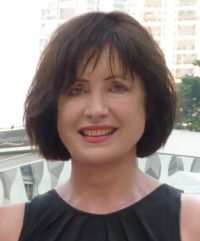Producing a golf tournament broadcast can be a daunting task. Doing it well might be the toughest job in sports television. Using familiarity of the field, the predictability of the outcome, resources and how meaningful the result is, as criteria I would say a Champions Tour (excuse me the PGA TOUR Champions) event is by far the easiest to produce, then the PGA TOUR and then the LPGA Tour. The Web.com Tour (again based on the four criteria listed) is, without question in my mind, the most difficult.
The basic story of most stick and ball sports can be told by simply pointing the camera at the ball. How and where it goes is, pretty much, how the story goes. That’s not to say those sports are easy, it’s just to say they are easier than golf. In golf, the producer has to pick and choose which ball to show. Instead of one playing field, there are 18. There are no built in, scheduled TV timeouts (play doesn’t stop while the commercials are airing) and EVERYBODY is playing offense. On Thursday and Friday, (again except on the Senior… I mean, Champions… oops, PGA Tour Champions) play lasts all day so depending on the air times you can have half the field already finished, half the field not having started, or somewhere in between.

The person producing a golf tournament on TV makes hundreds of decisions during a broadcast, not the least of which include who to show, when to show them, whether to show them live or on tape, when to interrupt action for a leaderboard, a promo, or a feature and when to leave the action for good to go to commercial break. The best ones go with the flow, the worst stick to a script. He or she certainly has help in making those decisions but the final call ultimately falls on their shoulders. Thursday is almost always the hardest day. There is no story yet and everybody is starting from scratch. As a producer, you know some of the players that will be featured in your coverage because you’ve had a hand in determining the groupings but there is no guarantee those hand-picked players will play well. One of your worst nightmares is the perfect storm of a late afternoon airtime, half the field in the house (including the leaders) and the first page of a leaderboard that likely won’t change the entire time you are on the air. That’s the situation that faced the producer on Thursday of the Swinging Skirts.
PICK A STORY, THEN TELL IT
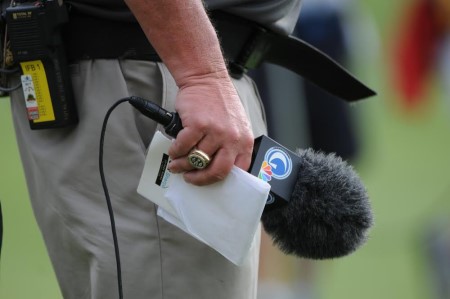 The LPGA came on the air at 3 PM PT with So Yeon Ryu in the house with an amazing 9 under par 63. A full-screen leaderboard featured eight players per page and all eight that day, playing a very difficult golf course, were 4 under par or better and finished. That leaderboard wasn’t likely to change and if it did it would be by one name, two at best. Putting on my producer hat I figured there were three choices for a plan. Show the stars, arranged in threesomes, and stay with them scores be damned, use the never changing leaderboard as an opportunity to stretch the envelope and show as many players as possible or hope somebody makes a charge from out of the pack and deploy resources to cover that round. The “featured groups” that day (the ones assigned an on course announcer) included Lexi Thompson, Anna Nordqvist, Ha Na Jang, Paula Creamer and Minjee Lee. I was curious to see which approach was chosen.
The LPGA came on the air at 3 PM PT with So Yeon Ryu in the house with an amazing 9 under par 63. A full-screen leaderboard featured eight players per page and all eight that day, playing a very difficult golf course, were 4 under par or better and finished. That leaderboard wasn’t likely to change and if it did it would be by one name, two at best. Putting on my producer hat I figured there were three choices for a plan. Show the stars, arranged in threesomes, and stay with them scores be damned, use the never changing leaderboard as an opportunity to stretch the envelope and show as many players as possible or hope somebody makes a charge from out of the pack and deploy resources to cover that round. The “featured groups” that day (the ones assigned an on course announcer) included Lexi Thompson, Anna Nordqvist, Ha Na Jang, Paula Creamer and Minjee Lee. I was curious to see which approach was chosen.
The telecast hit the ground running at 6:00 PM ET straight up and, after a short intro, got to the golf. It began with one highlight of Ryu’s great round (remember it happened early and to get more highlights would have been a drain on both resources and budget). During the next 12 minutes of live golf coverage, I saw 9 players hit a total of 15 golf shots, interrupted by or going to commercial with 1 minute of full screen leaderboards. All in all, as a friend of mine in the UK, would say (if I had a friend in the UK), a “boffo” segment. As expected, we were shown Ryu, Creamer, Thompson, Lee, Nordqvist as well as Michelle Wie, Juli Inkster, Ai Miyazato and Moriya Jutanagarn. I was surprised we did not see one single shot of Ha Na Jang. During the following several segments the strategy came into focus; the focus was going to be star power. An hour into the telecast, the number of players shown had increased from 9 to 16 but the majority of the focus was on Thompson, Creamer, and Wie. The first page of the leaderboard never changed. At 52 minutes in we saw Ha Na Jang for the first time as she was getting into a golf cart and withdrawing from the event. An hour and 11 minutes into the broadcast a new name surfaced on the second page of the leaderboard, Candie Kung. That would have signaled decision time in the truck for me. Specifically, should I transfer resources in the form of at least one camera from my scheduled coverage to Kung who was playing the front 9? On the couch, my answer was the same as if I would have been in the truck at Lake Merced, “send a camera to Kung.” The producer in California must have thought differently.
DO YOU ROLL THE DICE OR STICK TO THE SCRIPT?
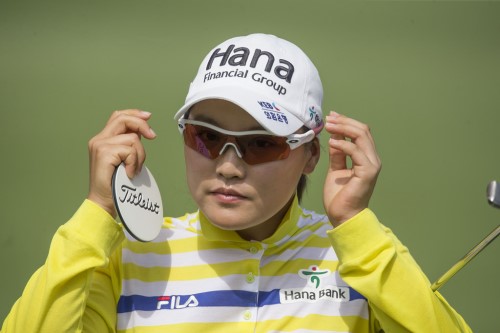
Lake Merced Country Club is, by comparison, a relatively tiny piece of land for a championship golf course. It’s easy to get around so getting a camera from the back nine to the front shouldn’t have taken more than a few minutes. At 7:17 PM ET Candie Kung made another birdie, this one at the 3rd hole, to get to -4, the best score on the golf course. Still with no coverage she parred the 4th hole, then at 7:52 PM ET, 41 minutes after getting to -3, she made her first appearance in the broadcast making a short birdie putt on the 5th to jump to the first page of the leaderboard at -5. For my money, that 41-minute gap was the only potential misstep in the three hour broadcast and even calling that a misstep is debatable. Kung could have made bogey or worse at 4 and made the move moot. She didn’t and then went on to get it to 7 under par. The call to move may have been a tad late but it was the right one to make. In three hours, viewers saw 26 players in all hit 196 golf shots. I might have shown a few more by cutting back on some of the 11 minutes of junk (full page leaderboards, unnecessary network promos, full screen graphics and necessary sponsored elements) but only a few more. Michelle Wie got the most love as we saw 29 of her 73 shots, Lexi Thompson was next with 28 (72) and we were treated to 27 Paula Creamer (72) golf shots.
Save for Candie Kung the names on the first page of the leaderboard never changed for three hours. As a producer that meant a double edged sword. It meant Thursday had the potential to suck but thanks to some good play and a good production, it didn’t. It also meant that Friday would feature all of those players who shot good scores on Thursday. I would have been licking my chops about that in the truck and I looked forward to Friday’s show. Sorry to say I was disappointed.
Despite the fact that most of the players on the first three pages of the leaderboard were in action when 6 PM ET rolled around the first segment on Friday was three minutes shorter and showed five fewer players hit two fewer golf shots than Thursday. So Yeon Ryu had coughed up her lead, overtaken by Haru Nomura and since both were playing in the coverage window we could expect to see a lot of them. Lydia Ko was also on the golf course and the leaderboard so it was a no brainer to see her too. The announcers were deployed to Ko’s group (In Gee Chun and Stacy Lewis) and Gerina Piller’s group (Brooke Henderson and Cristie Kerr).
IN GOLF AS IN COMEDY, TIMING IS EVERYTHING
I mentioned earlier that in addition to deciding who to show a producer must also make the decision when to show that person. Part of the help a producer gets during a broadcast is from an associate producer. That person’s job is to not only give information as to hitting order but whether or not “who’s next” is actually ready to play. The LPGA has been on TV hundreds of times in the past five years and Lydia Ko has been a factor, if not the outright star, of many of them. By now everyone should be well aware of the fact that the world’s number one female player is, as the great Henry Longhurst would say, “funereal” when it comes to pace of play. Lydia is great but she is slow. For me, a slow player, no matter how good, was always an opportunity to show somebody else. On Friday we saw Ko play 38 golf shots, at least 10 of those could have still be seen by the viewer while adding shots of someone else on the leaderboard.
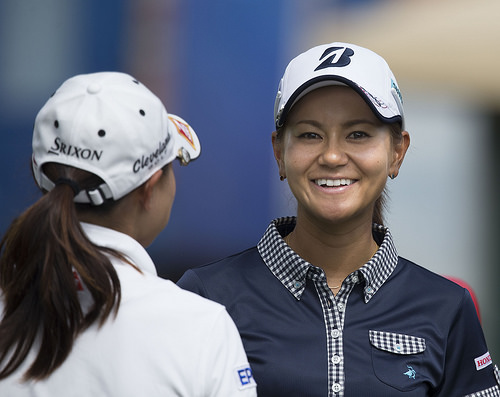
In all on Friday, we saw 21 players hit 208 golf shots. That was five fewer competitors but 15 more shots than Thursday. Ko led the way with 38, Gerina Piller was shown 35 times and leader Haru Nomura hit 31 shots on TV. That’s a total of three players but exactly half of all the shots shown. No one else had as many as 20 shots, the closest were In Gee Chun with 19, So Yeon Ryu with 16 and Brooke Henderson with 12. To further illuminate the missed opportunities on Friday for some reason we watched Stacy Lewis (playing with Ko and Chun) hit the ball 12 times but we had no idea who was playing in the same group with Haru Nomura (it was World Golf Hall of Fame member Dame Laura Davies and Hee Young Park who shot even par). For the first hour, we never saw Danielle Kang, Lee-Anne Pace, Karine Icher, Catriona Matthew, Brittany Lang, Julie Yang, Xi Yu Lin, Min Lee or Su Oh (all were under par). Matthew, Ji, and Lin would make a brief appearance near the 90-minute mark, Oh at the end of the second hour and Danielle Kang with a half an hour left.
I repeat producing golf on television is hard, hundreds of decisions have to be made. It just seemed to me that better ones were made on Thursday than on Friday. It happens.
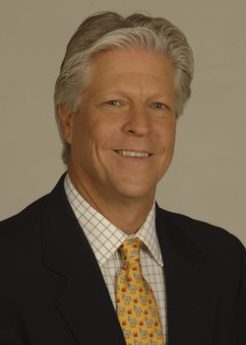
 Keith Hirshland’s experience has taken him all across the country, covering sport’s most famous athletes and television’s most interesting and charismatic personalities. Having worked at both the local affiliate and national network levels, Hirshland was on hand for the beginning stages of ESPN2 and one of the first forty people hired at the Golf Channel when the world’s first niche sports channel began its preparations in 1994. For years, he was part of the production team for golf’s nationally televised Skins Game. Hirshland has worked alongside sports television’s most iconic figures and his book ‘Cover Me Boys‘ features great behind-the-scenes stories from more than 30 years in the sports broadcasting business.
Keith Hirshland’s experience has taken him all across the country, covering sport’s most famous athletes and television’s most interesting and charismatic personalities. Having worked at both the local affiliate and national network levels, Hirshland was on hand for the beginning stages of ESPN2 and one of the first forty people hired at the Golf Channel when the world’s first niche sports channel began its preparations in 1994. For years, he was part of the production team for golf’s nationally televised Skins Game. Hirshland has worked alongside sports television’s most iconic figures and his book ‘Cover Me Boys‘ features great behind-the-scenes stories from more than 30 years in the sports broadcasting business.
Follow more of Keith Hirshland’s writing on his Cover Me Boys blog.
Photo credits:
Feature image, Paula Creamer and Golf Channel by Bob Shank
So Yeon Ryu via license
Ai Miyazato via license





